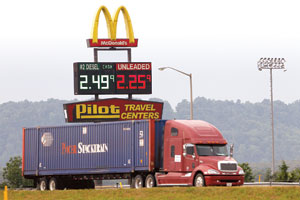Diesel Price Drops 5.1¢ to $2.617

The slide in the U.S. diesel average price reached an 11th straight week, with the Department of Energy reporting another decline Aug. 10, this time by 5.1 cents a gallon to $2.617.
Retail prices for commercial trucking’s main fuel declined in all major regions of the country for both the week and relative to the same time last year, DOE’s Energy Information Administration said after its weekly survey of fueling stations.
The cumulative value of the 11-week falloff is worth 29.7 cents, or 10.2%, since May 25.
A year ago, the national average price for trucking’s main fuel was $3.843 — the highest price over the past 12 months. U.S. diesel prices now are at the same level they were in October 2009.
DOE also said the retail gasoline average price dropped for the fourth straight week, by 6 cents a gallon to $2.629, EIA said. As with diesel, it declined in all major regions. The four-week decline is worth 20.5 cents. Gasoline is 87.6 cents lower than a year earlier.
Crude oil did nothing to suggest it would soon push diesel and gasoline prices back up. On Aug. 11, oil futures contracts on the New York Mercantile Exchange closed at $43.08 a barrel, the lowest close since March 2009, when the economy was still contracting in recession and the stock market hit bottom.
The year-to-date high close for crude was $61.43 a barrel on June 10.
Third-quarter “profitability could get another boost for truckers if sustained,” Jonathan Starks, director of transportation analysis for FTR, said on Twitter.
“The price has gone down incredibly swiftly. We’re in the throes now of analyzing the effect,” Wes Parker, owner and founder of AmeriCarrier Inc., said of the decline in fuel prices.
“Trucking is a penny industry, so any savings goes directly to the bottom line,” said Parker, whose nine trucks based in North Ridgeville, Ohio, pull flatbed loads through the eastern half of the country.
Fuel surcharges, he said, help protect the company when fuel prices go on an extended increase, but they don’t cover everything. When prices drop steadily over time, though, cash flow improves.
Bloomberg News attributed the Aug. 11 oil-price decline to strong oil production throughout the Middle East and the announcement by China that it is devaluing its currency, the yuan. Devaluation is usually a sign of economic slowness and a means for cutting the prices of exports.
Separately, the Energy Information Administration said Aug. 11 in its monthly Short Term Energy Outlook that it has trimmed back some price projections from the previous month.
“The diesel fuel retail price, which averaged $3.83 per gallon in 2014, is projected to fall to an average of $2.86 per gallon in 2015 — 2 cents per gallon lower than in last month’s [outlook], and then rise to $3.03 per gallon in 2016,” the report said.
Refinery woes in the Midwest and California have led to higher gasoline prices but have not affected diesel.
“EIA projects regular gasoline retail prices to average $2.63 per gallon during the third quarter of 2015, or 11 cents per gallon higher than in last month’s [outlook], and $2.55 per gallon in 2016,” EIA said.
EIA forecasts OPEC crude oil production to increase by 600,000 barrels per day in 2015 and decrease by 200,000 barrels per day in 2016. The report said Iranian oil production could be very important, but currently not enough is known on what will happen and when. In addition, world oil inventories are projected to continue rising, at least through 2016.
U.S. consumption of diesel and other distillate fuels also is expected to increase through 2016. EIA said this year’s growth should be 2.3%, or 90,000 barrels a day more than the 2014 rate. Distillate consumption is projected to expand by 1.7%, or 70,000 barrels a day in 2016.
“This growth is driven by increasing manufacturing output, foreign trade and marine fuel use,” the EIA report said.




